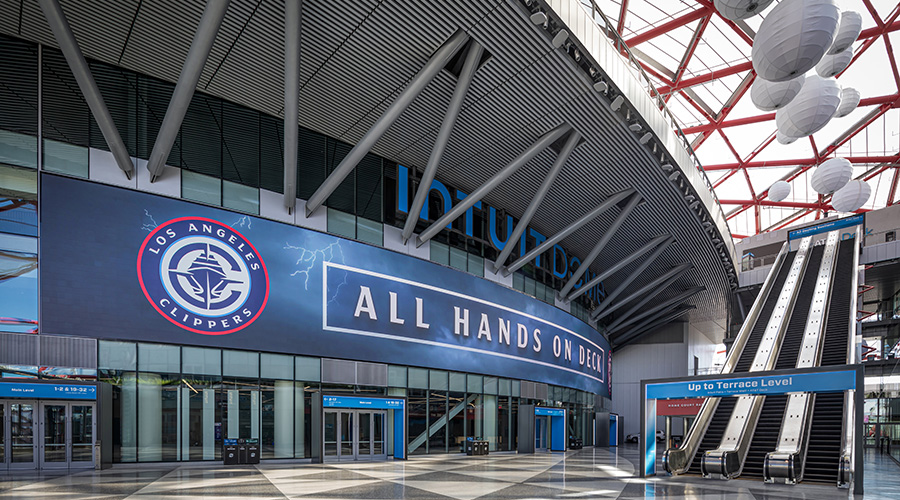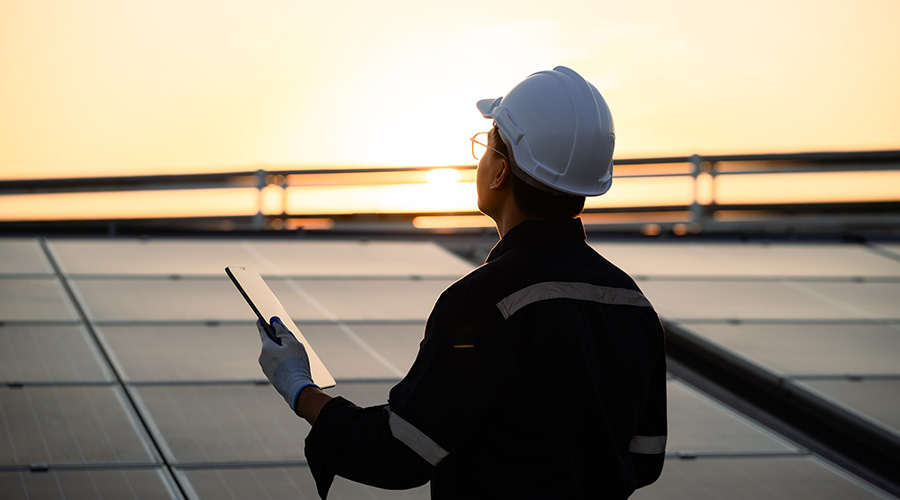Using LEED the Right Way
Also in this report
The sustainable design movement has gained immense popularity in commercial and institutional real estate nationwide. According to the U.S. Green Building Council (USGBC), the green building market is expected to exceed $12 billion in 2007, with approximately 3 percent of new commercial developments in the United States pursuing LEED certification.
Clearly, commercial properties are being influenced by sustainable design principles. But sometimes projects may not be as holistically green as they could be. That’s because motivations for incorporating green strategies vary. Motivations may include one, some or all of the following: reduce long-term operating costs, attract tenants, provide a more comfortable and productive environment for employees, be a good environmental steward, reduce the time required to get a building permit (e.g., Chicago’s Green Permit program), or obtain the public relations benefits that LEED certification may bring.
Some detractors claim that LEED is nothing more than a marketing ploy. However, many more people believe that LEED is an important third-party certification for green buildings and that most owners genuinely wish to do the right thing within the constraints of their values and budgets. Facility executives should consider the apparent gaps between marketing, social and environmental issues and smart business.
All too often, developers, owners, designers and facility executives only go after the low-hanging fruit, earning upon a project’s completion the right to say that a property is LEED-certified without having made a significant commitment to resource efficiency or good indoor environmental quality much beyond business as usual.
One particular recurring complaint about LEED always seems to revolve around bike racks. In most major cities, there are bike racks everywhere around town. Most would agree that bicycle riding is a good environmental strategy because it relies on human energy as opposed to petroleum. Simply providing a safe place to lock bikes and a place to shower may encourage people to ride their bikes to work or exercise during the middle of the day, and LEED provides a credit for incorporating those strategies into a building.
However, it is important to consider the particular project. If it’s a project in a rural location, then the bike racks are superfluous and not really a green strategy at all. Yet the same number of points can be earned for including them as can be earned by using a cool roof or other more expensive energy-related technologies.
Evolution is Coming
LEED is evolving; it is a grocery list of measures that meet current criteria and standards, with a nutrition label that demonstrates a project’s level of greenness. As with any list, it can be updated and modified at any time. USGBC has been gathering input from a wide variety of stakeholders and adding strategies that will receive Innovation in Design points. (See Briefing on page 22.) Think of this model as the next evolution of a particular software suite. It’s a means of updating LEED and thinking about sustainable design concepts without issuing a whole new version of LEED.
For instance, a relatively new concept much discussed recently is the zero-energy building. There are many definitions of zero energy, only some of which actually translate into a very efficient building. Given current technology and know-how, a building that uses about 50 percent less energy than a traditional building should be very possible if the owner, facility executive and design team take an integrated approach and use creative thinking to reduce the size of heating and cooling systems. However, simply going for zero energy by purchasing renewable energy credits may not be the smartest policy, as money could be better spent to improve building efficiency.
The building team should ask important questions: How can the most resources be saved? What resources should be saved? In the process of saving resources, are the goals for the building being met?
It is important to consider how to maximize the efficiency of systems so the overall construction and long-term operating costs are minimized.
A New Way to Draw the Lines
Having a Gold or Silver certification is not just about hanging a pretty plaque on a lobby wall or adding a section to a marketing pamphlet. For some project teams, using LEED means thinking about design in a new way. Traditionally, design has been linear — the architect makes the initial design decisions based on input from the owner and the rest of the team follows the architect’s lead. Input is provided by both owner and developer, but the central hub is with the architect first and then the rest of the design team.
Remember the “quality circle” approach? Members of teams offered input on ways to improve the quality of the product or process. That is similar to what LEED can accomplish if a team follows an integrated approach.
A good place to start on the LEED process is a goal-setting workshop (often called an eco-charette or sustainable design charette) at a project’s inception. On projects that start with such a meeting, it’s evident that the project takes shape much quicker and the design team and owner come to a clear agreement about the goals for the project.
The eco-charette sets the direction for the project and provides a framework for going forward. When goals are set early and all of the project stakeholders are included in the process — including owner, facility executive, building occupants and maintenance personnel — the project team has a much easier time making value judgments when it comes time to make tough budget decisions.
Commercial and institutional property owners can set their projects apart by incorporating design concepts that touch as many internal and external environmental conditions as possible. Employee well-being — things like comfort levels, good indoor air quality, high-quality lighting and daylight, and the like — are often melded with corporate initiatives such as corporate growth and values and financial flexibility to uncover new ways to improve a property.
Incorporating external environmental considerations, like natural resource use, recyclability and reductions in pollution is important and has a broader social component. Connection to community and government channels are two rapidly growing issues in which properties are being asked to add value, as property is just as much a part of an economic landscape as any money spent within it.
If facility executives consider green design principles before a site is selected (as opposed to later in the design process, or, even less optimally, when construction begins), it is much easier to have that site approved by all parties and, thus, achieve high-performance goals that meet LEED certification.
Equally important is fully understanding site conditions and what can be achieved. For example, during a charette for a gut rehab of an existing, nearly windowless building, the fact that employees wanted good daylight and indoor air quality to optimize their productivity was discussed. By identifying sustainable design goals such as these, the design team could focus on the systems that would have the most impact on the facility occupants. In this case, significant daylight was added to the building through the use of both clerestories and new windows. The goals outlined during the charette became a powerful incentive for the building owner not to cut costs in those areas.
It goes without saying that change takes time, and green building in general and LEED specifically are still in their infancy. LEED is already forcing design teams to work more closely together and think about systems and ideas that they might not have previously thought about. This is crucial to getting beyond thinking about LEED as a checklist of credits that can be achieved one by one.
USGBC recently made an important change to LEED — requiring a minimum level of energy efficiency above the energy standard it had previously used — which now forces design teams to think more carefully about energy use and hopefully to come up with better systems. There’s still work to be done in this area, but things seem to be moving in the right direction.
As facility executives, architects, engineers and contractors continue to work together and learn more about building green, it’s possible to advocate for higher standards of sustainable design that provide lasting environmental solutions and help create a better tomorrow. 
Helen J. Kessler, FAIA, is principal of HJKessler Associates and a LEED-accredited professional. She has more than 25 years of experience in sustainable design, energy efficiency and renewable energy.
|
|
|
CHAIR
Sandy Wiggins
Consilience LLC
IMMEDIATE PAST CHAIR
Kevin Hydes
Stantec
CHAIR ELECT
Rebecca L. Flora
Pittsburgh Green Building Alliance
|
SECRETARY
Gail Vittori
Center for Maximum Potential Building Systems
TREASURER
Joe Van Belleghem
Buildgreen Developments Inc.
FOUNDER (EX-OFFICIO)
David A. Gottfried
WorldBuild Technology Inc.
|
PRESIDENT, CEO and FOUNDING CHAIRMAN
S. Richard Fedrizzi
U.S. Green Building Council
1800 Massachusetts Avenue, NW
Suite 300
Washington, DC 20036
1-800-795-1747
|
| briefings |
|
Bill Clinton to Open Greenbuild
Former President Bill Clinton will deliver the keynote speech of the opening plenary session of Greenbuild, the world’s largest conference and exposition dedicated to green building. The event will be held at McCormick Place in Chicago, Nov. 7-9, 2007.
“Reducing carbon dioxide emissions that lead to climate change is a key area of focus, and it’s being addressed by the Clinton Climate Initiative, with green building as a cornerstone of that effort,” says USGBC President and CEO Rick Fedrizzi. “We are making a difference, and President Clinton’s unique ability to inspire individual action will add incredible momentum to this important work.”
Clinton’s keynote will kick off what is expected to be the largest Greenbuild ever. More than 20,000 people from all over the world are expected to take part in three days of educational sessions, LEED workshops, local green building tours, design charettes, networking events, and an 800-booth exhibit hall.
BOMA’s Seven-Point Challenge
Issued this summer, the Building Owners and Managers Association (BOMA) International Market Transformation Energy Plan includes a seven-point challenge for members to reduce use of natural resources and non-renewable energy sources, as well as waste production. The plan urges facility executives to aim for the following targets:
- Continue to work towards a goal to decrease energy consumption by 30 percent across portfolios by 2012.
- Benchmark energy performance and water usage through EPA’s ENERGY STAR benchmarking tool.
- Provide education to ensure that equipment is properly maintained and utilized.
- Perform an energy audit or retro-commissioning of buildings and implement low-risk, low-cost strategies to improve energy efficiency with high returns.
- Extend equipment life by improving the operations and maintenance of building systems and ensure equipment is operating as designed.
- Through leadership, positively impact your community and your planet by helping to reduce your industry’s role in global warming.
- Position yourself and the industry as leaders and solution providers to owners and tenants seeking environmental and operational excellence.
According to BOMA, buildings can achieve a reduction in energy consumption of up to 30 percent with low- and no-cost measures.
|
New Energy Standard
A new standard from the American Society of Heating, Refrigeration and Air-Conditioning Engineers (ASHRAE) offers a common basis for reporting building energy use and comparison of energy performance. ANSI/ASHRAE Standard 105-2007, Standard Methods of Measuring, Expressing and Comparing Building Energy Performance, provides a method of energy performance comparison that can be used for any building, proposed or existing and that lets users compare different methods of energy analysis.
This standard will help facilitate comparison, design and operation improvements and development of building energy performance standards, according to J. Michael MacDonald, chair of the committee that wrote the standard.
Past versions of the standard provided a basis for reporting energy use but had limited ability to express or compare performance.
Mandating Green
According to a recent report, the number of government green building programs has nearly tripled since 2004 — from 36 to 113. Of those 113 municipal programs, 101 are based on the LEED green building rating system: 28 do not require actual certification, while 73 mandate LEED certification for either municipal, commercial, multifamily, residential or industrial buildings. For private commercial developments, 62 municipalities have programs and policies in place.
The report — Government Green Building Programs Inventory — was first compiled in 2004 by the University of Wisconsin-Extension and Flad & Associates. The database was updated this year by UW-Extension. The report can be downloaded (PDF)
|
ADJUSTING LEED ON THE FLY
Over the last few months, USGBC has begun working towards its goal of making LEED a more dynamic rating system. As part of that effort, USGBC has announced building strategies that will receive LEED Innovation in Design (ID) credits. Previously, ID credits had been reserved for sustainable design strategies above and beyond the traditional requirements of LEED. And while design teams can still use ID credits for this purpose, identifying these specific strategies that will also achieve ID credit allows USGBC effectively to change LEED without having to introduce a new version of the entire rating system.
Here’s a roundup of strategies that will achieve an ID credit:
- ) Using building products and materials that have been certified as carbon neutral by a reputable, independent third-party certifier. The product’s entire line of supply and manufacture must be certified climate neutral.
- ) Using the Cradle to Cradle program for certified building products. Cradle to Cradle (C2C) assesses products on a range of criteria, such as the use of safe and healthy materials; design for material reuse and recycling; efficient use of energy and water throughout production; and strategies for social responsibility. The Cradle to Cradle design paradigm was developed by William McDonough and Michael Braungart, and the certification program is administered by their firm, McDonough Braungart Design Chemistry.
- ) Using products certified under the Sustainable Materials Rating Technology (SMART) and California Gold consensus standards. SMART and California Gold are almost identical consensus standards developed respectively by the Institute for Market Transformation to Sustainability and the State of California for all carpet purchasing. They assess products on a range of criteria throughout the global supply chain, such as use of safe and healthy materials; material reuse, recycling, biobased organic products with EPA Best Management Practices; energy efficiency, renewable energy, and water reuse; wood chain of custody; and social equity.

| projects |
Building B Earns A+ With Platinum Certification
The philosophy for buildings at Arizona State University’s Biodesign Institute seems simple enough: “Our research attempts to imitate nature’s design,” says George Poste, the Institute’s director. “So in constructing our facilities, we strove for minimal impact on the natural environment that inspires us.”
Mission accomplished.
The Biodesign Institute’s new $78.5 million, 175,000-square-foot Building B has been certified at the LEED Platinum level. The building, which connects with the 172,000-square-foot LEED Gold-certified Building A at all levels via glass walkways, is one of only 40 Platinum-certified buildings in the United States.
Building B features large expanses of glass, the purpose of which is to bring the scientific source of inspiration into the building. All offices have views of the Sonoran Desert garden, and a central atrium skylight runs the length of both buildings, allowing natural light into all levels of the four-story buildings. The height was limited to four stories to encourage occupants to use stairs, rather than energy-consuming elevators. Laboratories and office spaces are transparent, giving each a view of the other to encourage collaboration.
Designers also focused on strategies to make the building water efficient, a key green goal in the Arizona desert. A 5,000-gallon water cistern collects air conditioning condensate and uses it for irrigation, eliminating the need to use potable water for irrigation. Rain water from the roof and paving is routed directly to the native desert landscaping. Low-flow lavatories, kitchen sinks, showers and waterless urinals use 30 percent less water than conventional fixtures. (For more on water conservation, see “How Water Works for LEED” in this issue.)
Energy-efficient strategies in the building include office occupancy sensors that control lighting and a variable air volume exhaust system that reduces energy use in laboratory spaces. The top portion of the interior shade louver system is automatically controlled to maximize daylight penetration by reflecting diffuse light onto the ceilings. The building includes a reflective roof membrane and high-albedo paving that reduce energy and mitigate the Phoenix urban heat island effect.
More than 60 percent of construction waste was recycled and the building uses roughly 15 percent recycled material, including aluminum ceiling panels, recycled-content carpet and rubber stairwell flooring. Terrazzo floors were made with local materials, including area river rock.
Corporate HQ Scores LEED-EB Platinum
The first building outside of California to be certified at the Platinum level of the LEED for Existing Buildings (LEED-EB) program shows how important it is to start with a building that is not only green but also smart.
When Armstrong World Industries constructed its headquarters building in 1998, it followed many of the principles of LEED for New Construction (LEED-NC), which was then being developed. Although the organization never attempted to have its new headquarters certified under LEED-NC, it did take steps to improve the indoor environmental quality of the workplace and reduce energy use. Other green measures included narrow floorplates and light shelves to provide daylight to employees throughout the building and the use of materials from sources within a 500-mile range when possible.
The building was also designed with an element not always mentioned in green building discussions: a sophisticated control system. That system has helped save energy and improve indoor air quality. And it paid an unexpected dividend when the company decided to seek LEED-EB certification. Gathering information for LEED-EB documentation can be challenging.
“The control system gave us lots of information,” says Jim Baker, director of campus facilities, who also spearheaded construction of the building.
Although an intelligent green building offers a head start on LEED-EB, the path to certification is strenuous. “We took people that had full time jobs and added LEED certification to their responsibilities,” says Baker. “Having a staff that really knew the building was a big asset.”
Because the building itself already met many of the criteria for LEED-EB, the certification process did not require major capital investments. The company did spend money on water conservation measures, such as low-flow aerators on faucets, dual-flush toilets and zero-water consumption urinals. Those steps cut the building’s water use by 48 percent and paid for themselves in a year, Baker says.
Other green measures included a cleaning contract that specified green cleaning, purchase of 70 percent of the facility’s power from wind sources, the use of native plants requiring no irrigation and steps to encourage alternative transportation.
|
Related Topics:












